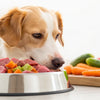How to Feed Your Dog Raw Food on a Budget: A Comprehensive Guide
- Houndsy
Table of Contents
- Introduction
- The Benefits of Raw Dog Food
- Understanding the Components of a Balanced Raw Diet
- Affordable Sourcing Options for Raw Food Ingredients
- Cost-Effective Meal Planning Strategies
- Tips for Efficient Storage and Preparation
- The Houndsy Kibble Dispenser: A Stylish Solution
- Conclusion
Introduction
Did you know that transitioning your dog to a raw food diet can significantly improve their coat health, digestion, and energy levels? As responsible pet owners, we often seek to provide our furry friends with the best possible nutrition. Yet, many of us shy away from raw feeding due to concerns about costs and logistics. This blog post aims to eliminate those worries by explaining how to feed your dog raw food on a budget without sacrificing quality or nutritional value.
Feeding your dog a raw diet can be both rewarding and challenging, especially if you're navigating the financial aspects. As we dissect the affordable options available, we'll arm you with actionable strategies to make the transition smoother and cost-effective. By the end of this post, you’ll not only understand the essentials of raw feeding but also how to implement a budget-friendly feeding routine that keeps your wallet happy.
In this article, we will cover:
- The benefits of raw dog food
- Understanding the components of a balanced raw diet
- Affordable sourcing options for raw food ingredients
- Cost-effective meal planning strategies
- Tips for efficient storage and preparation
- Why the Houndsy Kibble Dispenser is a game-changer for feeding routines
So, are you ready to explore how to give your dog a raw food diet without breaking the bank? Let’s dive in!
The Benefits of Raw Dog Food
Embracing a raw diet can yield numerous health benefits for our dogs. Here are some reasons why many pet owners are making the switch:
Improved Digestion and Nutrient Absorption
Raw dog food often contains fewer fillers and artificial additives than commercial kibble, leading to improved digestion. Dogs have evolved to eat raw meat, which can help this feeding method foster better nutrient absorption.
Enhanced Coat and Skin Health
A raw diet rich in healthy fats can improve your dog’s coat quality. Ingredients like fish and eggs provide omega-3 and omega-6 fatty acids, contributing to a shinier, healthier coat and less skin irritation.
Increased Energy Levels
With a raw diet, many dog owners report notable increases in energy and activity levels. This is likely due to the higher protein content and more natural ingredients, which aid in overall health and vitality.
Reduced Allergies and Health Issues
Switching to a raw diet can alleviate allergy symptoms and other health issues related to certain kibble ingredients. This is because raw food is generally more bioavailable, allowing for better utilization of nutrients and potentially fewer allergic reactions.
Better Dental Health
Chewing raw meaty bones can help maintain your dog’s dental hygiene by reducing plaque and tartar buildup. This natural form of dental care supports oral health without the need for expensive vet visits.
Considerations
While there are many benefits, transitioning to a raw diet also requires due diligence. Let’s ensure we understand the components of a balanced meal before we explore budget-friendly options!
Understanding the Components of a Balanced Raw Diet
When feeding your dog raw food, it's essential to create balanced meals. A correctly balanced raw diet typically consists of:
Muscle Meat
Muscle meat makes up the bulk of a raw dog food diet. This includes cuts such as chicken thighs, beef chunks, and pork tenderloin. Aim for a ratio of around 70-80% muscle meat in your dog’s overall diet.
Bones
Raw bones provide essential minerals and help with dental hygiene. Always opt for raw bones; cooked bones can splinter and pose serious risks. Types of bones to include are chicken necks, turkey necks, and ribs.
Organ Meats
Organ meats are nutrient-dense and should make up about 10-15% of your dog's raw food intake. Consider options like liver, kidneys, and heart. These proteins contain essential vitamins that are often lacking in standard commercial dog food.
Vegetables and Fruits
While dogs are primarily carnivorous, small amounts of dog-friendly vegetables and fruits can offer added fiber and nutrients. For example, consider including carrots, blueberries, or pumpkin for added health benefits.
Supplements
Depending on your dog's needs, additional supplements like fish oil or multivitamins may be beneficial. Always consult a veterinarian before introducing any new supplements.
Affordable Sourcing Options for Raw Food Ingredients
Transitioning to a raw diet doesn't have to come at a steep price. Here are some budget-friendly sourcing options for raw dog food ingredients.
Local Butchers
Building a relationship with your local butcher can be incredibly beneficial. They often offer discounts on bulk purchases or have 'off cuts' that are perfect for dog food.
Wholesale Clubs
Shopping at places like Costco or Sam's Club allows you to buy in bulk at significantly reduced prices. Look for large packs of chicken drumsticks or ground meat; these can be both affordable and convenient.
Farmers Markets
Visiting farmers markets can yield fresh produce and sometimes even raw meat products. Many local farmers are happy to sell leftover or less desirable cuts at a discount.
Online Retailers
Don’t overlook online retailers that specialize in raw dog food. Check for bulk purchasing options and sales; some sites offer subscription services that can further reduce costs.
Community Resources
Consider joining local or online dog owner communities. Many pet owners share resources, including local suppliers known for good deals on raw materials.
Cost-Effective Meal Planning Strategies
Planning your meals is crucial when feeding your dog a raw diet; it helps to stay organized and budget-conscious. Here are some strategies to ensure your raw feeding routine remains economically sustainable:
Buy in Bulk
Purchasing large quantities of meat can significantly reduce your costs. Divide them into meal-sized portions and freeze what you won't use immediately. This way, you'll always have raw food on hand without needing to make frequent purchases.
Create a Meal Plan
Dedicate some time each week to plan how to balance the various components of your dog’s diet. By mixing different protein sources and incorporating seasonal vegetables, you can keep meals varied and exciting for your dog.
Use Leftovers Creatively
If you cook for yourself, consider repurposing leftover meats or dog-friendly veggies into your dog’s raw meals. Just ensure that any scraps are free from spices and sauces that may not be dog-friendly.
Establish a Routine
Feeding routines not only help you save money but also make managing your dog’s diet easier. Well-fed dogs are more likely to adhere to consistent routines, and you can adjust meal portions based on their weight and health needs.
Tips for Efficient Storage and Preparation
Storage and preparation are vital components of a raw feeding routine. Here are some tips to help you work smarter, not harder:
Invest in a Freezer
Having a dedicated chest freezer can be a true game-changer. It allows you to buy in bulk and store raw ingredients without the worry of spoilage.
Freeze Meal Portions
Portion out the meals into containers or bags before freezing. This ensures you don’t have to handle large quantities each time, simplifying the feeding process.
Use Proper Storage Containers
Ensure you use high-quality, air-tight containers for your dog’s raw food. This helps maintain freshness and avoids cross-contaminating other food items in your kitchen.
Meal Prep Days
Set aside specific days for meal preparation. This could be once a week or once a month, depending on your schedule. Use this time to prepare and organize your dog's meals for easy access and serving.
The Houndsy Kibble Dispenser: A Stylish Solution
Feeding routines can often become cluttered and chaotic, particularly when you have a mix of raw and dry foods or treats. This is where the Houndsy Kibble Dispenser steps in! Our stylish, functional design not only enhances your pet feeding experience but also blends seamlessly into your home décor.
Ergonomic Convenience
With a convenient crank at standing height, the Houndsy Kibble Dispenser eliminates the need for parents to bend down, making the feeding process simpler and more comfortable.
Perfect Portions Every Time
Our dispenser is designed to deliver perfect portions every time you feed your dog, ensuring they receive exactly what they need without the hassle of measuring.
High-Quality Materials
Constructed with high-quality, durable materials, the Houndsy Kibble Dispenser is built to last, making it a reliable addition to any pet owner’s feeding routine.
Auto-Locking Mechanism
The auto-locking mechanism prevents accidental dispensing by curious paws or tiny fingers, providing peace of mind for parents of exuberant pets or young children.
Explore how our Houndsy Kibble Dispenser can enhance your dog feeding experience today! Order Now.
Conclusion
Feeding your dog raw food on a budget is not only possible but can also be a joyful journey toward improved health and happiness for your furry friend. By understanding the benefits of a raw diet, sourcing affordable ingredients, and planning efficiently, we can elevate our feeding routines while keeping costs manageable.
Consider adopting these practices into your own pet care regimen and witness the difference it can make in your dog's life. Remember, the choices we make today can lead to healthier tomorrows for our pets.
So, do you feel inspired to start a raw feeding journey? Are there any questions that remain unanswered related to your own feeding practices? Let’s continue this conversation together!
FAQ
What is a raw dog food diet?
A raw dog food diet consists of uncooked meat, bones, organ meats, and sometimes fruits and vegetables, designed to mimic a dog's ancestral diet.
How can I ensure my dog's raw diet is balanced?
To ensure a balanced diet, aim for a variety of muscle meats, bones, organ meats, and consider nutritional supplements. Consulting a veterinarian or a canine nutritionist can also help.
Is raw feeding safe?
Raw feeding is generally considered safe, but requires attention to food storage, preparation, and sourcing to reduce the risk of contamination. Practicing good hygiene is essential.
What if my dog refuses to eat raw food?
If your dog refuses raw food, gradually mix it with kibble or try different proteins until you find something they enjoy.
How do I store raw dog food?
Raw dog food should be stored in airtight containers in the freezer or refrigerator. Portioning out meals can help with storage and accessibility.
Can I feed my dog fruits and vegetables?
Yes, small amounts of dog-safe fruits and vegetables can be beneficial; however, these should only constitute a small portion of the overall diet.
By weaving together affordability and health, we hope to assist you in carving out a unique feeding experience for your dog. Let’s elevate the feeding ritual together, both in simplicity and design, with Houndsy’s innovative products.













